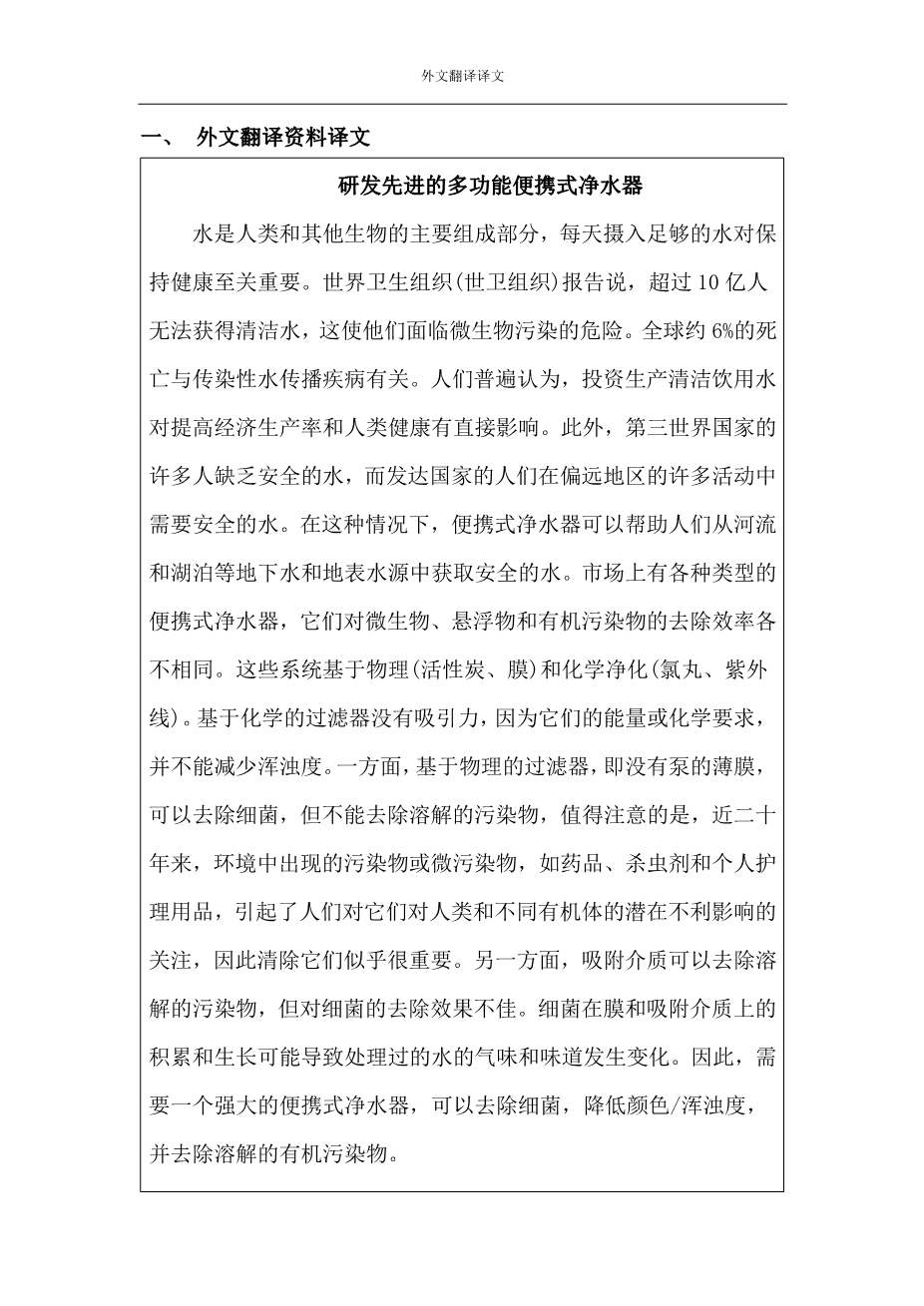Development of an advanced multifunctional portable water purifier
M.Taheran.P.Kumar.M.Naghdi,S.K.Brar.E.J.Knystautas,M.Verma,R.Y.Surampalli
Nanotechnology for Environmental Engineering[J] (2019) 4:7
Water is the main constituent of human and other living organisms, and consumption of enough water on a daily basis is crucial to stay healthy. World Health Organization (WHO) reported that more than a billion people do not have access to clean water which exposes them to the danger of microbial contamination. Approximately 6% of global deaths are associated with the contagious waterborne diseases. It is widely accepted that investing in the production of clean drinking water has a direct influence on improving economic productivity and human health. Besides, many people in the third world countries lack safe water and people in developed countries need safe water for many activities in the remote areas. In this case, portable water purifier can help provide safe water from ground and surface water sources, such as rivers and lakes. Different types of portable water purifiers are available in the market with varied efficiency for the removal of microorganisms, suspended solids, and organic pollutants. These systems work based on physical (activated carbon, membrane) and chemical purification (chlorine pill, UV light). The chemical-based filters are not attractive due to their energy or chemical requirement and their inability in the reduction in turbidity. On the one hand, physical-based filters, the membranes that work without pump, can remove bacteria but not dissolved pollutants. It is noteworthy that in recent two decades, the presence of emerging contaminants or micropollutants such as pharmaceuticals, pesticides, and personal care products in the environment raised concerns over their potential adverse effects on human and different organisms, and therefore their removal seems important. On the other hand, adsorption media can remove dissolved pollutants, but it is inefficient for bacteria. Also, the accumulation and growth of bacteria on both membrane and adsorption media may lead to change in the odor and taste of treated water. Therefore, a robust portable water purifier is required which can remove bacteria, reduce color/turbidity, and remove dissolved organic pollutants.
The current research paper investigated a three-stage design for portable water purifier which is able to remove bacteria, remove and degrade micropollutants, and reduce the color and turbidity. In this design, three membranes, i.e., antibacterial, biocatalytic, and adsorptive, were fabricated through electrospinning and placed in series to be able to remove different types of contaminants. These nanofibrous membranes have fiber diameter of around 300 nm and specific surface area of around 12 m2/g.
Activated carbon from the waste water purifier for supercapacitor application
Guojin Li1amp;Qiang Liamp;Jianglin Yeamp;Guangsheng Fuamp;JunJian Hanamp;Yanwu Zhu
J Solid State Electrochem [J](2017) 21:3169–3177
Nowadays, people pay more and more attention on safe drinking water due to increasing health concerns and continuous improvements in lifestyle. According to The World Water Organization, the global water purifier market is expected to witness a double-digit growth during 2013–2019. AC has been recognized as one of the most popular and widely used adsorbents in water treatment throughout the world. As we know, AC (filter carbon) in water purifier needs to be replaced when reaching its use limit. Not only it is a waste of resources but also may cause environmental pollution if the waste filter carbon is discarded after reaching its use limit. Based on the view of resource conservation and environmental protection, this work explored the recycling of waste filter carbon in a household water purifier as the electrode material for supercapacitor. It was found that, after heat treatment and KOH activation, the waste filter carbon shows outstanding electrochemical performance.
Early-life exposure to humidifier disinfectant determines the proHyun-Ju Cho
Hyun-Ju Cho, Soo-Jong Hong,So Yeon Lee, Donguk Park, Seung-Hun Ryu, Jisun Yoon, Sungsu Jung6, Eun Lee,Song-I Yang
Cho et al. BMC Pulmonary Medicine [J](2019) 19:261
Humidifier disinfectants (HD), as household chemicals, have been used to prevent microbial growth in humidifier water tanks since 1994 in South Korea and contain various concentrations of chemicals, including oligoethoxyethyl-guanidinium chloride (PGH), polyhexamethylene-guanidine phosphate(PHMG), and chloromethylisothiazol/methyl-isothiazol(CMIT/MIT).These chemicals have been widely used in either industrial or various consumer products, including cosmetics, as biocides. However, HD inhalation from a humidifierrsquo;s aerosolizer was finally identified as a respiratory toxicant after an epidemic outbreak of idiopathic childhood interstitial lung disease (chILD) characterized by spontaneous air leak, rapid progression, and high mortality among immunocompetent children in South Korea in 2006. Thereby, the novel forms of HD associated lung injury (HDLI) were defined in 2011, and HDLI has been added in the chILD classification of exposure-related ILD, worldwide. HD use in early-life was also recently found to independently increase the risk of childhood asthma
Emission of iron and aluminum oxide particles from ultrasonic humidifiers and potential for inhalation
Yao Wenchuo; Gallagher Daniel L; Marr Linsey C; Dietrich Andrea M;
Water Research[M]Volume 164, 1 November 2019, 114899
Ultrasonic humidifier use is a potential source of human exposure to inhalable particulates. This research evaluated the behavior of insoluble iron oxide and aluminum oxide
剩余内容已隐藏,支付完成后下载完整资料
英语译文共 8 页,剩余内容已隐藏,支付完成后下载完整资料
资料编号:[246025],资料为PDF文档或Word文档,PDF文档可免费转换为Word
以上是毕业论文外文翻译,课题毕业论文、任务书、文献综述、开题报告、程序设计、图纸设计等资料可联系客服协助查找。



